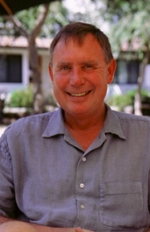
Mark Owen Francis
Professor of Landscape Architecture, Emeritus
Professor Emeritus Mark Owen Francis came to the UC Davis campus prior to the Academic Year 1980-81, by way of UC Berkeley (BS, Landscape Architecture) and Harvard Graduate School of Design (Master of Landscape Architecture), and a previous Assistant Professorship at City University of New York. Immediately, his presence on our faculty jump-started a period of growth and development in the newly-accredited Landscape Architecture Program. He remained on the faculty until his retirement in 2010, completing a stellar academic career of research, publishing, teaching, mentorship, and professional practice of local regional, national, and global significance.
Mark’s contributions to the academic world and the professional community extends beyond his many publications. Mark always embraced the idea that he shared with his students that designing should be fun. The joy he found in his work can be seen in the places he created and in the research he undertook. Mark’s research and creative practice resided at the intersection of landscape architecture, environmental psychology, geography, art, and urban design. His focus was people-centered and proactive, and explored the design and meaning of built and natural places through human engagement, participation, and group creativity.
Mark translated his research to numerous award-winning design projects, among them being Davis Central Park, home of the nationally recognized Davis Farmers Market, and the remarkably successful “Picnic in the Park.” As one of the nation’s most successful examples of landscape architecture leading to human well-being, Mark’s design for the Davis Central Park was awarded the Centennial Medal by the American Society of Landscape Architects (ASLA). This project exemplifies Mark’s activism and professionalism as do several other projects in Davis such as the Davis Greenway Plan, which has been implemented in great part to become the Davis Bike Loop, and Davis Commons.
Mark was a prolific and inspiring writer as well as a designer. He was also a successful collaborator in his design work and his writing. Others were drawn to work with Mark, like a magnet is attracted to steel. Among his most successful collaborations and publications is his collaborative volume with Professor Emeritus Randy Hester (UC Berkeley) entitled The Meaning of Gardens, a compilation of stories on why gardens matter from diverse viewpoints. The book captured a popular audience and was named one of the best garden books by the New York Times Book Review. His most influential publication may be his monograph, A Case Study Method for Landscape Architecture, originally published by the Landscape Architecture Foundation (LAF) in 1999, and re-released as a 20-year anniversary edition in 2019. The Case Study Method has influenced and inspired the work of researchers and professionals. Spurred by this publication, LAF has funded more than 100 projects following this method through their Case Study Investigation program.
Mark realized the importance of sharing his knowledge with the landscape architecture profession, his fellow researchers, and students. Along with his memberships and engagement with the Council of Educators in Landscape Architecture and the ASLA, Mark was an active member of the Environmental Design Research Association (EDRA). He served on the organization’s Board of Directors and as its Chair. One of the accomplishments of which he was most proud was the creation of the EDRA Great Places Award. Unlike typical design awards, this award was established to highlight and promote the design and construction of environments that support the needs and activities of varied populations.
Mark brought his collaborative skills and his proactive practice approach to the UC Davis Landscape Architecture Program. He would come up with an idea…a big idea, drawn on the back of an envelope or a piece of flimsy design paper, and soon all who worked with him would be pitching in. It was this kind of moment, this kind of energy, that he disseminated to his students and coworkers throughout his career. Mark was well respected for his curricular development, expansion of a public lecture series, and most importantly, his creation of the department’s Center for Design Research (CDR). Mark served as the CDR director for over twenty years during which time he facilitated and published applied research manuscripts on all aspects of research by faculty, graduate students, and collaborators in every conceivable realm of landscape architectural practice.
Mark was a consummate “people person,” and all who interacted with him grew and thrived from his infectious enthusiasm and encouragement. He actively sought to bring like-minded international colleagues together and introduced students to influential researchers and academics. Mark made space to engage each of us where we were on our path. He listened, acknowledged and guided hundreds of us through the challenges we faced; he always offered encouragment and inspired us to challenge ourselves and grow. Several of his former students are now leaders at educational institutions in roles as professors, department chairs, and deans. A large network of collaborators and supporters exist because of Mark. His talent for connecting people in affectionate collaboration…we must call it “affectionate” because his engagement with others was never without genuine positive emotion…was like a human neural network or an electrified, interconnected energy grid, always growing, always making new connections. His mentorship reminded us to stay true to what brought us bliss and encouraged us to be kind to ourselves and others. So, while Mark had an office in our building and a faculty position in our department, he brought into our program a whole, joyous world of people, and channeled their energy directly into our curriculum, our faculty, our students, and our community.
Mark’s actions were a direct reflection of his values of family, community, design, knowledge, and democracy. He helped forge the department as it is today, with a large, diverse faculty, and a permanent physical home at the main entrance to the campus. His imprint on the landscape architecture + environmental design program, our city, and our profession is indelible, and will live forever.
Patsy Eubanks Owens
Lucas Griffith
Rob Thayer
